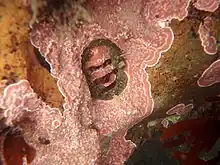Mopalia muscosa
Mopalia muscosa, the mossy chiton, is a species of chiton, a polyplacophoran, an eight-plated marine mollusk. It is a northeastern Pacific species which occurs from British Columbia, Canada, to Baja California Mexico.[1][2][3]
| Mopalia muscosa | |
|---|---|
 | |
| Scientific classification | |
| Domain: | Eukaryota |
| Kingdom: | Animalia |
| Phylum: | Mollusca |
| Class: | Polyplacophora |
| Order: | Chitonida |
| Family: | Mopaliidae |
| Genus: | Mopalia |
| Species: | M. muscosa |
| Binomial name | |
| Mopalia muscosa (Gould, 1846) | |
| Synonyms[1] | |
|
Chiton muscosus Gould, 1846 | |
This species is found in the middle and lower intertidal zone on exposed rocky shores. Mopalia muscosa can be 40 to 55 mm (1.6 to 2.2 in) in length. Mossy chitons are often covered by algae, barnacles, and limpets. The chiton's girdle is covered with coarse hair-like bristles or "setae".The visible exterior of the chiton's eight shell plates are typically a drab brown or grey-green, however on the underside the shell plates have a vibrant turquoise blue color. Some mossy chitons are biofluorescent mainly around the girdle and may show a bright glowing green color under ultra-violet or blue light.[4] Mossy chitons typically move about at night or when covered by a high tide in order to graze on the red and green algae of which their diet consists. Young chitons have a planktonic stage and later metamorphose and settle on the bottom as adults.
Gallery
 Mossy chiton found in Tribune Bay, Hornby Island British Columbia
Mossy chiton found in Tribune Bay, Hornby Island British Columbia A small specimen covered in and surrounded by encrusting Lithothamnion red alga
A small specimen covered in and surrounded by encrusting Lithothamnion red alga
References
- "Mopalia muscosa (Gould, 1846)". WoRMS. World Register of Marine Species.
- McLean, James H. (1978). Marine Shells of Southern California. Los Angeles: Natural History Museum of Los Angeles County. ISBN 0-938644-03-3.
- Cowles, Dave. "Mopalia muscosa – Invertebrates of the Salish Sea". inverts.wallawalla.edu. Retrieved 5 January 2019.
- "Marine Life Fluorescence at Monterey Bay Aquarium".